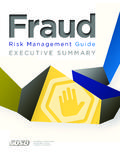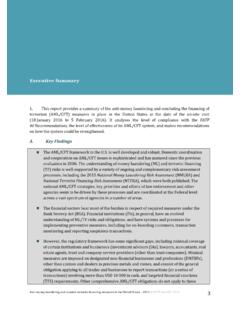Transcription of Electromagnetic Pulse: Effects on the U.S. Power Grid
1 Electromagnetic pulse : Effects on the Power Grid executive summary The nation s Power grid is vulnerable to the Effects of an Electromagnetic pulse (EMP), a sudden burst of Electromagnetic radiation resulting from a natural or man-made event. EMP events occur with little or no warning and can have catastrophic Effects , including causing outages to major portions of the Power grid possibly lasting for months or longer. Naturally occurring EMPs are produced as part of the normal cyclical activity of the sun while man-made EMPs, including Intentional Electromagnetic Interference (IEMI) devices and High Altitude Electromagnetic pulse (HEMP), are produced by devices designed specifically to disrupt or destroy electronic equipment or by the detonation of a nuclear device high above the earth s atmosphere.
2 EMP threats have the potential to cause wide scale long-term losses with economic costs to the United States that vary with the magnitude of the event. The cost of damage from the most extreme solar event has been estimated at $1 to $2 trillion with a recovery time of four to ten years,1 while the average yearly cost of installing equipment to mitigate an EMP event is estimated at less than 20 cents per year for the average residential customer. Naturally occurring EMP events resulting from magnetic storms that flare on the surface of the sun are inevitable. Although we do not know when the next significant solar event will occur, we do know that the geomagnetic storms they produce have occurred at varying intensities throughout history.
3 We are currently entering an interval of increased solar activity and are likely to encounter an increasing number of geomagnetic events on earth. In 1989, an unexpected geomagnetic storm triggered an event on the Hydro-Qu bec Power system that resulted in its complete collapse within 92 seconds, leaving six million customers without Power . This same storm triggered hundreds of incidents across the United States including destroying a major transformer at an east coast nuclear generating station. Major geomagnetic storms, such as those that occurred in 1859 and 1921, are rare and occur approximately once every one hundred years.
4 Storms of this type are global events that can last for days and will likely have an effect on electrical networks world wide. Should a storm of this magnitude strike today, it could interrupt Power to as many as 130 million people in the United States alone, requiring several years to recover. Mitigation technologies to protect the Power grid against such a costly EMP event can be developed, and in some cases do exist. This study consists of a series of comprehensive technical reports produced by Oak Ridge National Laboratory for the Federal Energy Regulatory Commission, the Department of Energy and the Department of Homeland Security and is being issued to provide the basis for a technical understanding of how EMP threats affect the Power grid.
5 1 Severe Space Weather Events Understanding Societal and Economic Impacts: A Workshop Report, National Academy of Sciences, 2008. i Electromagnetic pulse : Effects on the Power Grid These reports examine the EMP threats, their potential impacts and analyze potential solutions for preventing and mitigating their Effects . In order to avoid major disruptions to the grid, it will be necessary to: (1) develop, test and deploy mitigation technologies to automatically protect the Power grid from costly damage; (2) train bulk Power system operators to improve their situational awareness of EMP threats; and (3) improve reporting and monitoring of geomagnetic storm and Power grid events.
6 Background EMP threats raise grave concerns about the ability of the modern Power grid to successfully recover from the Effects of a major geomagnetic event. Since the last occurrence of a major geomagnetic storm in 1921, the Nation s high voltage (HV) and extra high voltage (EHV) systems have increased in size over tenfold. Longer transmission lines that span greater surface potentials act as conductors for the geomagnetically induced current (GIC) that can devastate the electrical grid. GIC poses the risk of catastrophic damage to EHV transformers and can lead to long-term outages of large portions of the grid.
7 Unlike the more familiar terrestrial weather threats that the electric Power grid is build to withstand, severe geomagnetic storms have a much larger geographic footprint, posing the risk of considerable equipment damage and long-term outages to major portions of the North American grid. The technical reports document a series of computer models used to estimate the impact of a major solar event by predicting the transformers that are at-risk from excessive GIC. By simulating the Effects of a 1 in 100 year geomagnetic storm centered over southern Canada, the computer models estimated the sections of the Power grid expected to collapse during a major EMP event.
8 This simulation predicts that over 300 EHV transformers would be at-risk for failure or permanent damage from the event. With a loss of this many transformers, the Power system would not remain intact, leading to probable Power system collapse in the Northeast, Mid-Atlantic and Pacific Northwest, affecting a population in excess of 130 million (Figure 1). Further simulation demonstrates that a storm centered over the northern region of the United States could result in extending the blackout through Southern California, Florida and parts of Texas.
9 Ii Electromagnetic pulse : Effects on the Power Grid iii Figure 1. Areas of Probable Power System Collapse In addition to causing the immediate damage and failure of transformers, there is also evidence that GIC may be responsible for the onset of long-term damage to transformers and other key Power grid assets.
10 Damaged transformers require repair or replacement with new units. Currently most large transformers are manufactured in foreign countries and replacements would likely involve long production lead times in excess of a year. The long-term Power outages associated with such a delay would pose unacceptable societal burdens. The two other types of Electromagnetic threats to the Power grid examined in this study are high altitude Electromagnetic pulse (HEMP) and intentional Electromagnetic interference (IEMI). While man-made, such threats can prove similarly devastating to the electrical infrastructure and produce similar harm to the Power grid.








